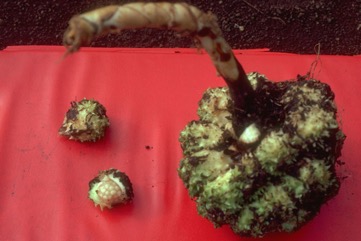Malamalai, Milmilau

A tropical plant. It grows wild in the tropical lowland rainforest up to about 800 m or 1000 m altitude.
Also known as:
Asabareng, Orom, Parahulu, Parahulu cardamom, Sil bange
Synonyms
- Amomum aculeatum Roxb.
- Amomum aurantiacum Ridl.
- Amomum ciliatum Blume
- Amomum flavum Ridley
- Amomum hatuanum Nees
- Cardamomum aculeatum (Roxb.) Kuntze
- Cardamomum ciliatum (Blume) Kuntze
Edible Portion
- Fruit
Where does Malamalai grow?
Found in: Andamans, Asia, India, Indonesia, Malaysia, Myanmar, Pacific, Papua New Guinea, PNG, Philippines, SE Asia, Thailand, Vietnam
Notes: There are about 150 Amomum species. They are mostly tropical.
Growing Malamalai, Milmilau
Cultivation: It grows wild from seed. Plants can be grown by division of the rhizome.
Edible Uses: The fruit are cooked and the seeds eaten. Sometimes the seeds of ripe fruit are eaten raw.
Production: Plants occur in primary and secondary forests in the tropics in Papua New Guinea and the Philippines.
Nutrition Info
per 100g edible portion| Edible Part | Energy (kcal) | Protein (g) | Iron (mg) | Vitamin A (ug) | Vitamin c (mg) | Zinc (mg) | % Water |
|---|---|---|---|---|---|---|---|
| - | - | - | - | - | - |
Malamalai, Milmilau Photos

References
Asiat. Res. 11:344. 1810 (As Amomum aculeatum)
Bau, B. B. and Poulson, A. D., 2007, Ethnobotanical Notes on Gingers of the Huon Peninsula in Papua New Guinea. Gardens’ Bulletin Singapore 59 (1&2): 23-34. 2007 (As Amomum aculeatum)
Borrell, O.W., 1989, An Annotated Checklist of the Flora of Kairiru Island, New Guinea. Marcellin College, Victoria Australia. p 42, 168 (As Amomum aculeatum)
Droop, A.J. & Newman, M.F., 2014, A revision of Amomum (Zingiberaceae) in Sumatra Edinburgh Journal of Botany 71: 193-258.
French, B., 1986, Food Plants of Papua New Guinea, Asia Pacific Science Foundation p 309 (As Amomum aculeatum)
Larsen, K., Ibrahim, H., Khaw, S.H., & Saw, L.G., 1999, Gingers of Peninsula Malaysia and Singapore. Natural History Publications (Borneo). p 70 (As Amomum aculeatum)
Leach, G. J., 1988, Bush Food Plants of the Blackwater and Karawari Rivers Area, East Sepik Province, Papua New Guinea. Science in New Guinea 14(2). p 98 (As Amomum aculeatum)
Peekel, P.G., 1984, (Translation E.E.Henty), Flora of the Bismarck Archipelago for Naturalists, Division of Botany, Lae, PNG. p 106, 105 (As Amomum aculeatum)
Plants of Papua New Guinea LAE herbarium record (As Amomum aculeatum)
Sukarya, D. G., (Ed.) 2013, 3,500 Plant Species of the Botanic Gardens of Indonesia. LIPI p 1059 (As Amomum aculeatum)
World Checklist of Useful Plant Species 2020. Royal Botanic Gardens, Kew